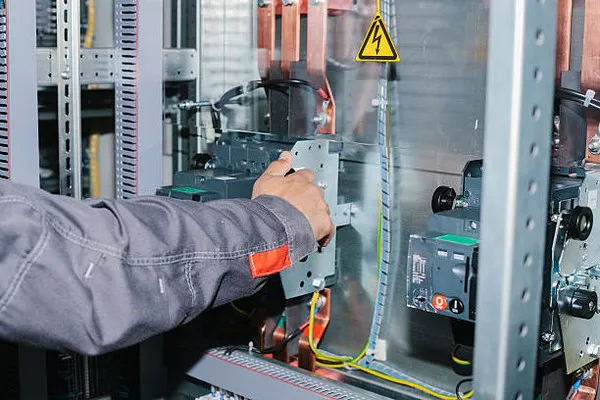Voltage transformers play a crucial role in electrical systems by transforming high voltages to lower, more manageable levels for measurement, control, and protection purposes. From power generation to distribution and consumption, voltage transformers facilitate safe and efficient operation across various industries. In this article, we delve into the fundamentals of voltage transformers, their types, functions, and importance in electrical systems.
Definition of Voltage Transformers
Voltage transformers, also known as potential transformers (PTs) or voltage instrument transformers, are devices designed to accurately measure and transform high voltages to lower, standardized levels suitable for instrumentation and control equipment. They ensure safe and efficient operation within electrical systems by providing precise voltage scaling while maintaining electrical isolation between the high-voltage circuit and the measuring or monitoring instruments.
Construction of Voltage Transformers
Voltage transformers typically consist of two main components: primary and secondary windings, along with a magnetic core. The primary winding is connected in parallel with the circuit carrying the high voltage to be measured, while the secondary winding is connected to the measuring instrument or relay. The windings are wound around a high-permeability core material, such as laminated steel or ferrite, to enhance magnetic flux linkage and minimize losses.
Working Principle of Voltage Transformers
Voltage transformers operate based on the principle of electromagnetic induction, wherein a changing magnetic field induces a voltage in a nearby conductor. When an alternating current flows through the primary winding of a voltage transformer, it generates a fluctuating magnetic field around the core. This magnetic field induces a proportional voltage in the secondary winding according to the turns ratio between the primary and secondary windings.
Types of Voltage Transformers
Voltage transformers come in various types to suit different applications:
Electromagnetic Voltage Transformers: These are the most common type and are widely used in industrial and utility applications.
Capacitive Voltage Transformers: Suitable for high-voltage measurements in electrical substations and power systems, these transformers employ capacitive voltage dividers to provide accurate voltage scaling.
Inductive Voltage Transformers: Designed for precise voltage measurement and protection in medium to high voltage systems, these transformers utilize inductive coupling between windings.
Combined Instrument Transformers: These transformers integrate both voltage and current measurement functions into a single unit, providing comprehensive monitoring capabilities.
Measurement Using Voltage Transformers
Voltage transformers are indispensable for accurately measuring high voltages in electrical systems. By stepping down the voltage to a safe and standardized level compatible with measuring instruments, such as voltmeters and protective relays, they enable precise monitoring, control, and analysis of power parameters.
Advantages and Disadvantages of Voltage Transformers
Advantages:
- Provides accurate voltage scaling for instrumentation and control purposes.
- Enables safe and efficient measurement of high voltages without exposing measuring instruments to hazardous conditions.
- Enhances system reliability and performance by facilitating accurate monitoring and control of electrical parameters.
Disadvantages:
- Introduces additional losses and inaccuracies due to factors such as winding resistance, core saturation, and temperature variations.
- Requires periodic calibration and maintenance to ensure accuracy and reliability.
- Can be susceptible to external electromagnetic interference, affecting measurement accuracy in certain environments.
Applications of Voltage Transformers
Voltage transformers find widespread application across various sectors, including:
Power Generation: Used in generators and substations for voltage monitoring and protection.
Transmission and Distribution: Deployed in electrical substations and distribution networks for voltage measurement and control.
Industrial Automation: Employed in industrial plants for monitoring and control of electrical equipment.
Renewable Energy: Integrated into wind turbines, solar power plants, and other renewable energy systems for voltage measurement and control.
Railways and Transportation: Utilized in traction systems and signaling equipment for voltage monitoring and protection.
Selection Guide for Voltage Transformers
Selecting the right voltage transformer involves considering several factors, including:
Voltage Rating: Choose a transformer with a voltage rating compatible with the system’s operating voltage.
Accuracy Requirements: Select a transformer with the required accuracy class for precise measurement and control applications.
Environmental Conditions: Consider factors such as temperature, humidity, and ambient electromagnetic interference to ensure reliable operation in the intended environment.
Physical Size and Mounting: Choose a transformer that fits within the available space and is suitable for the mounting requirements of the application.
Budgetary Constraints: Balance performance requirements with cost considerations to optimize the overall system design.
Maintenance of Voltage Transformers
Proper maintenance is essential to ensure the longevity and reliability of voltage transformers:
Regular Inspection: Conduct visual inspections to check for signs of damage, corrosion, or overheating.
Calibration: Periodically calibrate the transformer to maintain accuracy and reliability.
Cleaning: Keep the transformer and surrounding area clean to prevent dust buildup and improve heat dissipation.
Testing: Perform routine testing to verify performance and detect any abnormalities.
Environmental Protection: Protect the transformer from moisture, contaminants, and extreme temperatures to prevent degradation of insulation and components.
FAQs About Voltage Transformers
Q: What is the difference between a voltage transformer and a potential transformer?
A: Voltage transformers and potential transformers are synonymous terms used interchangeably to refer to devices that step down high voltages for measurement purposes.
Q: Can voltage transformers be used to step up voltage?
A: No, voltage transformers are specifically designed to step down high voltages to lower levels and cannot be used for voltage boosting purposes.
Q: What factors affect the accuracy of voltage transformers?
A: The accuracy of voltage transformers can be influenced by factors such as load impedance, temperature variations, harmonic distortion, and core saturation.
Q: Are voltage transformers safe to use in hazardous environments?
A: Voltage transformers are designed to provide electrical isolation between the high-voltage circuit and the measuring instruments, making them suitable for use in hazardous environments when installed and maintained properly.
See Also How Does An Auto Transformer Work
In conclusion
Voltage transformers are indispensable components in electrical systems, enabling accurate measurement and control of high voltages while ensuring safety and reliability. By understanding their construction, working principle, types, applications, and maintenance requirements, users can effectively utilize voltage transformers to enhance the performance and efficiency of their electrical infrastructure.

